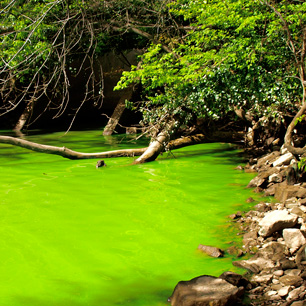Color
| EPA Secondary Drinking Water Standard |
15 color units |

Green water in the Potomac River, caused by an overabundance of algal growth.
In most cases, water takes on color as the result of organic matter from decaying vegetation. It is commonly a problem of surface water, and is rarely an issue for water from deep wells or springs. Color can also be a result of the presence of metals like iron and manganese.
Some common colors and what they indicate:
-
Yellow. Often referred to as “tannins,” indicates that humic acids are present.
-
Reddish or reddish brown water indicates iron (rust). The red color may be found on bathroom fixtures and laundry.
-
Blue or Bluish-Green usually indicates the corrosion of copper plumbing.
-
Green water can also be caused by dezincification of bronze alloys. In warm climates, green water may be caused by algae from reservoirs or rivers.
-
Dark brown or black indicates the presence of manganese and sometimes hydrogen sulfide.
-
Milky white, cloudy or foamy water is usually caused by air released as the faucet is opened.
Treating Color in Water
Treatment of color varies. Activated carbon is the most commonly used color reducer. Anion exchange (usually following a water softener) is a common treatment for tannins, and certain types of macropore carbon are also effective at tannin removal. Iron and manganese coloration are treated in the standard ways that iron and manganese are treated. See sections on iron, manganese and copper for methods of reducing these contaminants and consequently the color alterations that they cause.
Source: Massachusetts Department of Environmental Protection, Photo: WikiMedia, author: Sasha Trubetskoy
Site Index
Filtration Systems
- Aeration for Iron & Sulfide
- Backwashing Filters
(whole house & well units)
- Chlorine & Chemical Injectors
- Countertop Water Filters
- Emergency Filters
- Garden Hose Filters
- Reverse Osmosis, Residential
- Reverse Osmosis, Commercial
- Shower Filters
- Specialty Filters
- Ultraviolet Systems
- Undersink Filters
- Water Softeners
- Whole House Filters
Cartridges
Parts
- Replacement Parts
- Faucets
- Filter Media
- Fittings
- Housings
- O-rings
- Pumps
- Pura UV
- R.O. Parts
- R.O. Tanks
- R.O. Booster Pump
- VIQUA UV